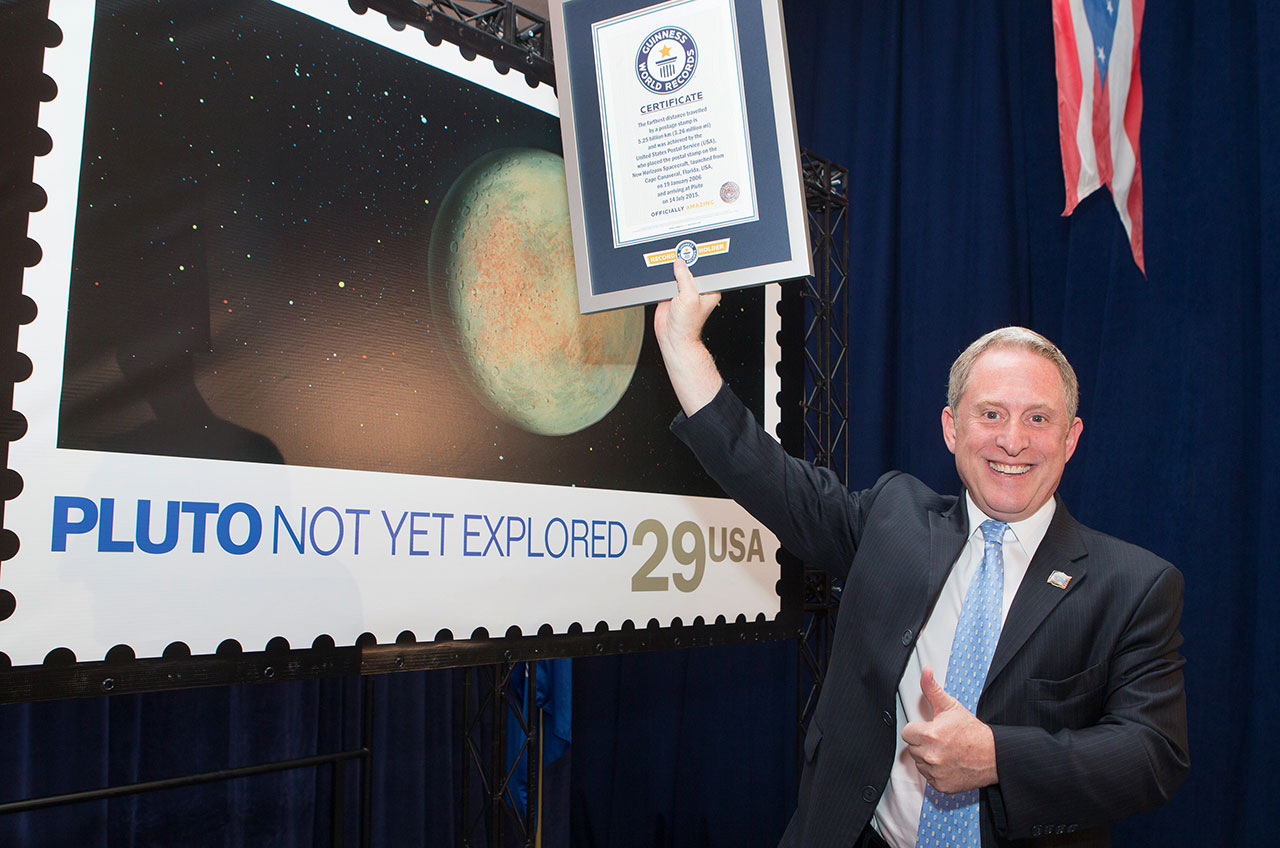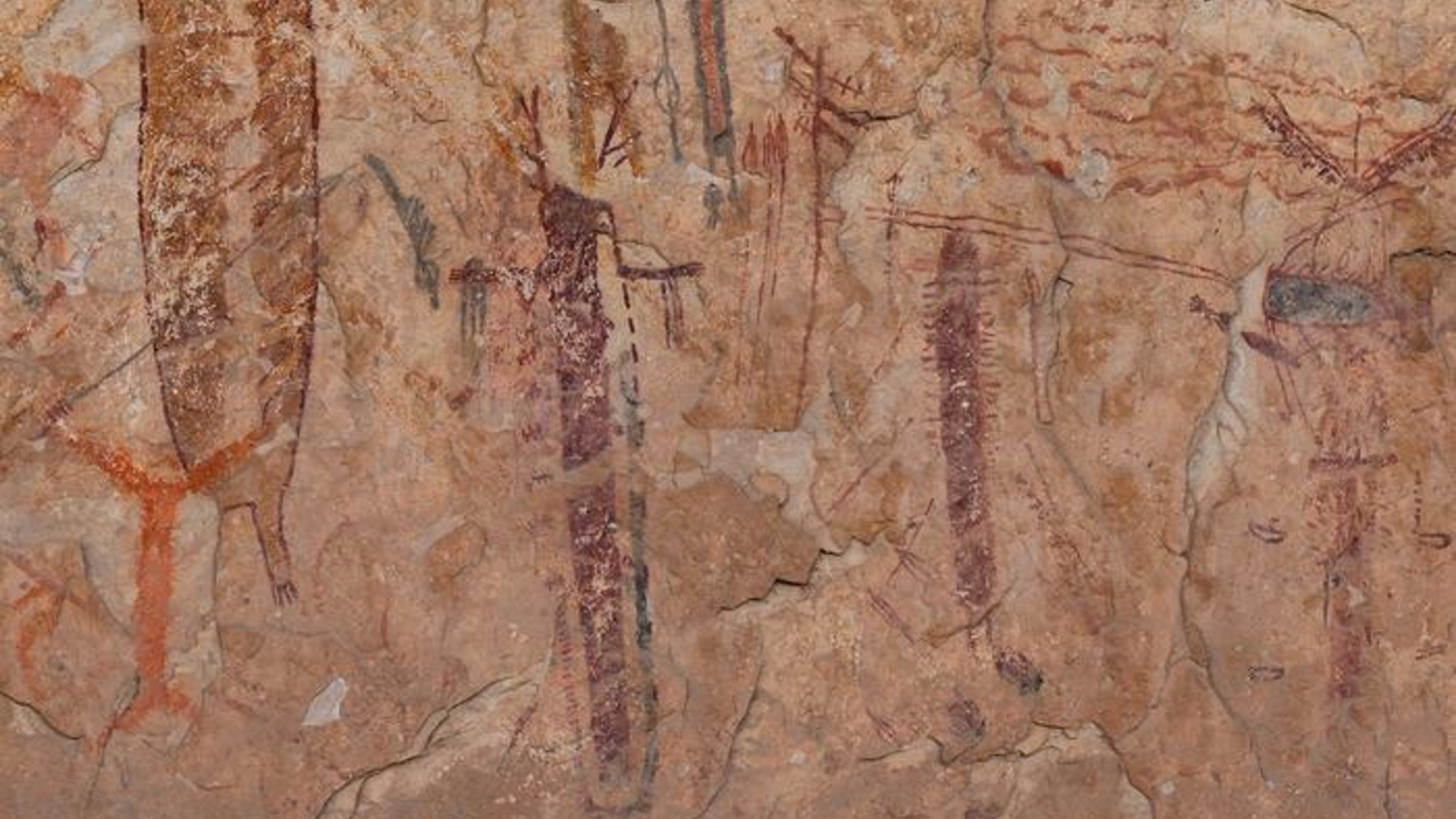Pluto Stamp Aboard NASA's New Horizons Probe Sets Guinness World Record

When NASA's New Horizons spacecraft flew by the dwarf planet Pluto one year ago this month, the mission set a number of records. The probe was the first to encounter the small world at the edge of our classical solar system, sending back images that revealed Pluto's surface for the first time.
But beyond its own mission of exploration, New Horizons also served as the delivery vehicle for a 1.5-inch by 1-inch (3.8 by 2.5 cm) relic that set a record of its own.
"The official record for the farthest distance traveled by a postage stamp is 3.26 billion miles [5.25 billion km]," said Jimmy Coggins, an official adjudicator for Guinness World Records, at a ceremony held Tuesday morning (July 19) at the United States Postal Service's (USPS) headquarters in Washington, D.C. [Amazing Space and Planet Stamps in Pictures]
"In 2006, NASA placed a 29-cent "Pluto: Not Yet Explored" stamp on board the New Horizons spacecraft on its way to Pluto and beyond," explained Jim Cochrane, USPS chief marketing and sales officer and executive vice president, in a statement. "That historic flyby with Plutotook place last summer — July 14, 2015, to be precise — after New Horizons travelled more than three billion miles in its nine-and-a-half-year journey."
The newly-affirmed record will extend for at least another 1 billion miles (1.6 billion km), as NASA recently announced that the New Horizons mission is journeying beyond Pluto to visit a Kuiper Belt Object (KBO) known as 2014 MU69 — considered to be one of the early building blocks of the solar system.
"The New Horizons project is honored to be recognized by Guinness World Records for its achievements," said Alan Stern, the mission's principal investigator at the Southwest Research Institute in San Antonio. "Among my personal favorites are being the fastest spacecraft ever launched, the first mission to explore the Pluto system, the mission that explored the farthest worlds ever visited — and now sending a U.S. postage stamp farthest from Earth!"
The 29-cent stamp was issued by the U.S. Postal Service on Oct. 1, 1991 as part of a set of stamps celebrating the robotic exploration of the solar system. Designed by artist Ron Miller, the stamp's artwork was based on the very little information known about Pluto at the time and included the caption, "Not Yet Explored."
Breaking space news, the latest updates on rocket launches, skywatching events and more!
"You know it says 'Not Yet Explored,' and I have to say, it was a beautiful stamp. It really inspired us when we were building New Horizons to explore this last of the classical planets," said Stern at Tuesday's record ceremony. "Well, we canceled that stamp last July when we flew by Pluto."
To mark the mission's accomplishment, the USPS issued a new set of stamps, appropriately titled "Pluto—Explored!" on May 31. The two stamps feature an artist's rendering of the spacecraft and an image of the dwarf planet as taken by New Horizons.
This is at least the second Guinness World Record set by the New Horizons mission. In 2006, the robotic probe was recognized for achieving the fastest speed at which a craft has departed from Earth, 36,250 mph (58,338 km/h).
To put that into some perspective, it took three days for the Apollo 11 spacecraft to reach the moon 47 years ago this week. New Horizons flew past the moon's orbit in just nine hours.
"When I started to look at the record, over 3 billion miles, I started thinking about the history of the Postal Service," said Coggins. "At one point in the early 1800s, to deliver a letter from the east coast to the west coast of the United States, it took four to seven weeks. In the mid-1850s, with the Pony Express, they found a more direct route and it still took 10 days to get from St. Louis to San Francisco. That is about 190 miles [306 km] a day."
"To think about this distance, 3 billion miles — that is about 131 [thousand] times around the circumference of the Earth and it was delivered in less than 10 years," Coggins said. "If the Pony Express was trying to deliver that far, they would be swapping ponies out for the next 47,000 years before it got there."
Follow collectSPACE.com on Facebook and on Twitter at @collectSPACE. Copyright 2016 collectSPACE.com. All rights reserved.

Robert Pearlman is a space historian, journalist and the founder and editor of collectSPACE.com, a daily news publication and community devoted to space history with a particular focus on how and where space exploration intersects with pop culture. Pearlman is also a contributing writer for Space.com and co-author of "Space Stations: The Art, Science, and Reality of Working in Space” published by Smithsonian Books in 2018.
In 2009, he was inducted into the U.S. Space Camp Hall of Fame in Huntsville, Alabama. In 2021, he was honored by the American Astronautical Society with the Ordway Award for Sustained Excellence in Spaceflight History. In 2023, the National Space Club Florida Committee recognized Pearlman with the Kolcum News and Communications Award for excellence in telling the space story along the Space Coast and throughout the world.


